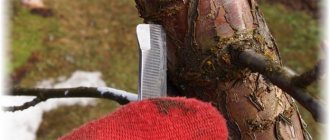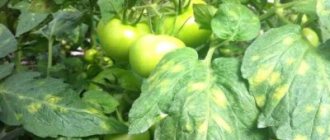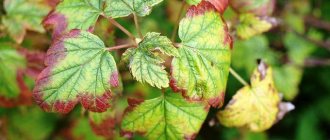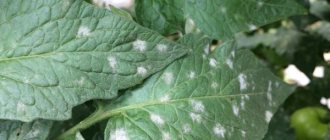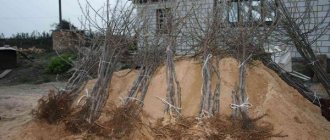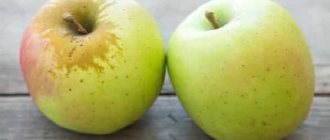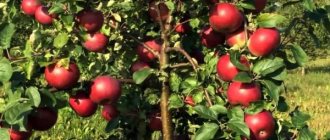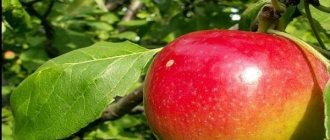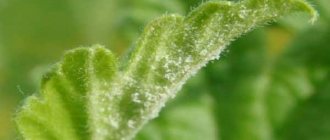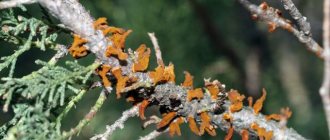Gardening » Apple tree
3
683
Article rating
Kira Stoletova
Rusty spots on apple tree leaves appear quite often. This phenomenon most often occurs due to the development of a fungal infection, or more precisely, rust. Advice from experienced gardeners will help you understand how to deal with this.
Treatment of rust spots on apple tree leaves
Apple orchard processing schemes
To remove rusty spots on apple tree leaves, you need to carry out a comprehensive treatment. Especially if the stains were discovered in the previous season.
Treatment should be carried out according to the following schedule:
- carry out the treatment for the first time in the spring, when the buds have just begun to bloom;
- the second - before flowering, when the buds swell or after flowering, before the fruit starts to fill;
- the third treatment – two weeks after the second, to consolidate the result.
Spraying should not be carried out during the flowering period or during fruit ripening. It is also necessary to ensure that the large plant is kept clean and receives all the necessary nutrition.
Reasons for the development and regions of distribution of apple tree rust
The following factors contribute to the appearance of rust on an apple tree:
- proximity to juniper thickets;
- warm and humid beginning of spring;
- warm winds at the end of spring.
Until recently, apple tree rust was a disease of limited distribution in Russia, since the combination of these three factors was observed mainly in the southern and coastal regions of the country. But the more active element of landscape design the juniper becomes, the more often apple trees in the Middle Zone become infected with rust.
Tip #1. In order not to give up coniferous rock gardens for fear of infecting the apple orchard, after purchasing juniper seedlings you need to treat them with fungicides.
If rust is detected on juniper, emergency measures must be taken to protect the apple trees.
Rusty leaves on an apple tree - what to do? Methods of treatment and prevention
You can only get rid of rust on apple tree leaves in a comprehensive manner. It is necessary to carry out complex treatments, preventive and protective measures.
Improvement of the orchard
There are a number of catalysts for the spread of fungal diseases. These include excess moisture and planting crops too often. The density of the crown of an apple tree is also often a favorable place for the life of a fungal culture.
Signs of an infected seedling.
In order for the garden as a whole to be healthy, you need to approach it with responsibility and attention. Crops need to be regularly looked after, watered and fed properly.
It is very important to inspect all crops before planting. Apple seedlings must be healthy, without visual manifestations of disease. It is worth paying attention to planting juniper in the garden. They are a potential risk area, if only because they are often brought for sale already sick.
Destruction of fungal colonies
If there is a large area where diseases develop, you need to cut and remove damaged plants as much as possible. Colonies do not settle on apple trees, but due to the wind, spores often fall on fruit trees and begin to have an impact.
It is conifers, and primarily juniper, that are the source of infection most often. Dense shoots provide the most favorable environment for the growth and activity of fungi.
If the damage on the branches is not yet very large in area, then it is the diseased branches that can be cut off. The rest of the plant will need to be treated with fungicidal preparations. But if the plant is already heavily infected, it will need to be completely removed. Moreover, the bush should be uprooted and burned, and the plot of land where it was located should be dug up and poured with boiling water.
Destruction of spores and consequences of infection
After the source of the apple tree disease has been eliminated, the rusty leaves must also be destroyed without pity. You also need to cut off the branches; if stains have already spread to them, they need to be burned immediately.
You also need to remove all weeds in the garden, except wormwood. It slows down the spread of the fungus and has a depressing effect on it.
The area under the apple tree and areas where conifers or weeds grew should also be treated well. They are first dug deep, then treated with copper sulfate, ammonium nitrate or urea. Preparations can be applied to the soil one at a time.
Pruning infected apple tree branches.
Causes of rust stains
The main source of apple tree rust is juniper plantings. The development of the disease begins precisely there. First, mycelium grows inside the wood and bark, which forms characteristic outgrowths after 1.5-2 years. Their development is favored by warm, humid weather. After ripening and drying, the outgrowths release spores, which are spread around with the help of the wind. This is how the infection spreads to apple trees. Spores caught on the leaves soon germinate, forming characteristic rust-colored spots.
Treatments for rust on apple leaves
Apple tree leaf rust is treated in several stages. One of them is treatment with various substances.
Copper-containing drugs
Copper preparations are a good cure for apple tree leaf rust. Can be used:
- one percent solution of Bordeaux mixture. The solution is used in the morning or evening, but before the onset of heat;
- Blue-Bordeaux, a similar contact action drug that does not lose its properties in any weather;
- contact fungicide Abiga-pik, which tends to stay on the outer parts of shoots and leaves for a long time, but does not penetrate into the tree tissue;
- Kuproskat, which is used for watering the tree trunk and removes all spores well;
- the drug Champion, which has the ability to protect the plant from the penetration of infection into the tissues of the apple tree.
All these drugs can be swapped and alternated.
Sulfur-based product
Colloidal sulfur is an excellent remedy for eliminating infection. The substance acts upon contact with the fungus and destroys it quite quickly. To prepare the working solution you need 40 grams of dry matter and 5 liters of water.
This is what colloidal sulfur looks like.
The same colloidal sulfur exists in a special form, easily soluble and dust-free. This is the drug Culumus.
Treatment should be carried out in good weather without wind, in the morning or evening. It is very important not to spray during flowering so as not to harm pollinating insects.
Fungicides are the main answer to the question of how to treat rust on an apple tree
There are a number of fungicidal preparations that quickly and effectively destroy rust. In the list below is the name of the drug and the quantity required to prepare a solution per 10 liters of water:
- 3 g Strobi;
- 40 g Tsineb;
- 3 g Vectra;
- 2.5 g Polyram;
- 2 ml Topaz.
To prevent the infection from becoming accustomed to the same drug, you need to alternate them. Also, when rust appears at the very peak of the fight against scab, there is no need to carry out a second treatment, you should wait a little.
Description of the disease
The appearance of orange dots on the apple tree is a sure sign of the development of a fungal infection. It does not immediately cause damage, but always has a strong effect on yield. Often gardeners do not immediately take emergency measures, citing being busy.
The appearance of rust can be observed in the last month of spring; it appears after rains. Signs of rust damage appear after flowering in late April or early May:
- yellowish spots on the leaves;
- spots of the same color on shoots and fruit branches.
The infection inevitably develops and by the end of summer the rusty speck grows and affects the leaves so badly that it hurts to look at them. By the end of the season, apple tree rust has completely affected all parts of the tree:
- large yellow-orange spots with small black dots on the upper side of the leaf;
- thread-like or cone-shaped formations on the back of the leaf (ethidia), spores ripen in them;
- infected leaves dry out and fly off much earlier than expected;
- large spots appear on the fruit, often near the calyx;
- apples grow small, deformed, lose their taste, and are often affected by rot;
- diseased shoots do not grow and remain short stumps;
- Severely damaged branches die, bark and wood crack on slightly damaged branches.
This disease, with its symptoms, resembles damage to an apple tree by black cancer.
Important! The sensitivity of apple trees to rust is directly dependent on the amount of precipitation. The wetter the summer, the more cases of rust infestation.
The reasons why apple tree leaves rust are quite simple. Rust on plants is caused by rust fungi.
Rust fungi can have one host plant or several. The fungus Gumnosporandium treme lloides, which causes rust on apple trees, has many hosts. Such fungi are the most dangerous and difficult to eradicate.
The cedar-apple rust fungus begins its development cycle on common juniper and ends on apple trees. Spores from the apple tree again infect the juniper and the two-year cycle of fungal development is repeated again and again until both plants die. Infection can occur if there is no more than 2 km between the juniper and the apple tree.
The fungus overwinters on juniper branches. In spring, orange growths appear on its branches; after wetting in the rain, they swell and become enveloped in mucus. Basidiospores germinate in it, looking like an orange coating, which are carried over a considerable distance.
The fashion for growing coniferous plants on the site has given rise to an outbreak of rust.
Some gardeners are unaware of the connection between the infection and juniper. They don’t know that they need to be treated at the same time.
The development of rust and the dispersal of spores begins at the end of the season. Kidney-shaped brown galls—growths—grow on the underside of the apple tree leaf. When the leaf is exposed to rain, the galls grow jelly-like tendrils or horns in the moist environment. The microscopic spores produced by these horns are carried by wind and insects. The spores infect only juniper.
Important! Rust does not cause significant damage to juniper and develops on it unnoticed for a long time.
Preventive measures to prevent infection
Preventive measures are those that help prevent infection. These include:
- maintaining the distance between crops, especially for conifers;
- correct pruning and crown formation;
- cleaning and digging the tree trunk circle to keep it clean;
- carrying out preventive spraying with fungicidal preparations;
- pruning apple trees and forming an unthickened crown;
- correct and timely fertilizers, in accordance with the season and the needs of the apple tree.
If coniferous plants were recently planted on the site, then it is better not to plant young seedlings of fruit crops nearby.
Systemic fungicides
For treating rust, fungicides are the number one remedy. It is with them that you need to start treating the disease at its peak. Especially if you want to hit the bull's eye. The best results in this fight are brought by contact and systemic-contact drugs. These primarily include:
- "Strobe";
- "Topaz";
- "Vectra";
- "Zineba";
- “Polishing.”
All drugs work approximately the same. They destroy fungal colonies. At the same time, they infect spores, from which, after exposure, fungi will never appear. They can be easily alternated, which makes it possible to avoid addiction. Since rust fungi have an excellent ability to adapt to chemicals. To do this, they wait out the adverse effects in the form of spores. And then they attack with even greater activity. Systemic fungicides are universal preparations that, when used correctly, can cure trees from rust infection once and for all.
What dosages should be diluted in 1 bucket of water:
- Strobe -2g;
- Topaz-2 ml;
- Vectra -2g;
- Polisher -2g.
For all of the above remedies, the rule of two applies. This way you can never go wrong when preparing a solution against pathogens. Only Zineba needs 40g.
If at the time of fighting rust, you managed to spray the apple trees, for example, against scab, then there is no need to carry out additional spraying. This will be enough to act on two types of pathogens at the same time.
Topaz
The drug has a powerful antifungal effect. It is produced in liquid and powder form. The consumption for an apple tree is 2 liters per 10m2. Treatment can be carried out several times, after waiting 2 weeks.
Strobe
An excellent drug with beneficial benefits. It can be used even during flowering. It is safe for bees. Spraying can be carried out in wet weather and at low temperatures. Highly effective in combating many fungi, especially rust.
Vectra
A good powerful drug for treatment. The active substance is bromuconazole. A young apple tree requires up to 2 liters. An adult fruiting tree needs 10-15 liters. The maximum frequency of spraying is no more than 3 times. Do not mix with other products.
People's Councils
People always test and apply all means earlier than even breeders and specialists in the cultivation of fruit crops. Important tips are:
- planting wormwood next to apple trees, the aromatic oils of which negatively affect the development of infection;
- constant digging of the tree trunk to prevent weeds from accumulating on the apple tree;
- the use of folk remedies to maintain immunity and protect against pests and diseases.
Wormwood as a method of fighting rust.
As practice shows, folk remedies are effective as protection, but more as preventative measures. If the disease has already manifested itself, then it would be best not to waste time and take serious protective measures.
Be careful juniper, why is the shrub dangerous for the apple tree?
When planning an orchard at the planting stage, it is important to take into account useful advice. Never plant juniper bushes next to apple trees. If the garden has already been laid a long time ago, and you discover such a combination, immediately take up the shovel. Replant the bushes somewhere further away, preferably to a park or small forest. You can simply get rid of them if your plot is no more than 10 acres.
The juniper tree is not a comrade, not a friend, but a very dangerous roommate. It is in it that pathogens of the disease appear, multiply and persist. Spores are carried by the wind to apple trees, causing a dangerous infectious process. Insects actively flying around the garden also contribute to infection. The spores comfortably overwinter in the needles, and in the spring they begin new attacks on the trees. If this process is not interrupted, you may soon be left not only without apples, but also without all the trees. Since, having eaten and played enough in the leaves, the pathogen moves to the trunk, branches, and fruits. First year shoots are especially sensitive to it.
Decorating dachas with conifers is fraught with the spread of disease in the form of an epidemic. If you are hesitant to get rid of your favorite spruce or pine tree, inspect it for infection. Colonies of the pathogen give the branches of coniferous plants a characteristic brown-rusty color.
There is a way out in this case too. Armed with a file and pruning shears, prune conifers. Dig the soil deeply or pour boiling water over it. Treatment with fungicides brings good results. Therefore, spray your coniferous pets every spring. And at the same time, do not forget to thoroughly cultivate the soil layer underneath them.
Remember that if you regularly care for juniper and Christmas trees, it is possible to stop the spread of the pathogen. With perseverance and perseverance, you will preserve not only apple trees, but also evergreen fuzzies.
In addition, there is evidence that even the complete destruction of juniper bushes will not save you from rust. Spores can travel enormous distances - 50 km or more. Even more so in strong winds. Therefore, the best way out is to be a caring owner and set aside time to care for the Christmas trees.
Prevention
Try to prevent rust from appearing in your garden, carry out preventive treatments, take into account the proximity of apple trees to conifers, and take immediate action when the first signs of infection appear.
Like any disease, rust is better prevented than treated. First of all, you will have to resolve the issue with decorative juniper. You should prioritize between a beautiful landscape and a rich harvest. Those for whom it is more important to preserve coniferous shrubs can simply cut down the apple trees and plant non-fruitful trees in their place. If a neighbor planted a juniper, then cutting it down on someone else’s property will not work.
In order to protect your garden from fungal spores entering the area from behind the fence, you can plant the area near the fence with wormwood. The bitter plant perfectly repels rust fungus and protects the host's crop.
In order not to deal with overgrown spores, it is best to carry out preventive spraying of the apple tree even before it is infected. This should be done in the spring after positive temperatures have established. You can also spray apple trees and other fruit trees with antimicrobial agents. This is done three times per season. The first spraying is carried out before the appearance of young foliage, the second - before the tree blooms, and the third - after flowering.
Regular inspection of apple trees for the appearance of various spots and changes in leaf color should become a habit of a good gardener, which will allow the disease to be noticed in the early stages and treated without loss of yield. In addition, timely preventive measures will prevent spores from entering the plant and preserve the apple tree throughout the spring-summer season.
Features of treatments
Since the pathogen is omnipresent, it is on leaves, bark, and shoots, it must be treated with special care.
To obtain a positive result, it is necessary to completely spray the entire orchard.
- You can’t spray it lightly and forget it for a long time - there’s no point in that. Such an event will not help the garden.
- The wood should be processed from top to bottom . Starting from the outside of the tree, you should move to the inside, and then return again. Complete wetting of all parts of the wood will ensure penetration of the drug and a decent effect. When processing, you must not forget about the trunk and the area around the trunk . Soil and grass should be no exception. The more thoroughly the spraying and complete wetting is done, the less likely it is that a second outbreak will return.
- The apple tree may not be alone in the garden. In addition, apple trees can also grow nearby. Every effort should be made to treat as large an area as possible (including neighbors).
- When preparing preparations for treatment, and having read the instructions, it is advisable to combine them with acaricidal substances . Thus, both the fungus and the insects that carry the pathogen will be destroyed.
Main reasons
Rust on apple leaves appears more often in the regions of the Crimean Peninsula, southwest and southeast of Ukraine and central Russia.
Contributing factors:
- warm climate with high ambient temperatures;
- prolonged drought;
- low humidity.
But there are other popular reasons that are worth mentioning.
Violation of landing rules
Often, illiterate planting of seedlings near areas of coniferous trees that are susceptible to fungal infectious diseases leads to the active spread of spores to healthy apple trees, whose leaves also rust over time.
Unfavorable neighbors are plants of the juniper family.
Infertile soil
An insufficient amount of nutrients in the soil layers is the reason for the deficiency of a number of components necessary for the full development of the fruit crop.
The result of growing not poor in vitamins and minerals in the absence of timely fertilizing is a disruption of metabolic processes and the appearance of rust on the foliage.
Mandatory ingredients include nitrogen, phosphorus, potassium, magnesium, iron, copper and manganese.
Weak immunity
Trees with reduced immunity cannot resist the emerging fungal infection and become an object for its active spread.
Apple trees growing in neglected areas filled with weeds often have leaves covered with rusty spots.
Signs of appearance
At the early stage of the disease, which appears in early June, the leaves of the tree become covered with orange-brown spots. They are egg-shaped and gradually increase in size. If measures are not taken to combat the violation during this period, growths will appear on the lower parts of the leaves by mid-July.
In addition, rounded spots are formed on the apple tree, which have a green-canary tint. They gradually grow and acquire an orange or carmine hue. Such spots are localized on the outer areas of the leaves.
It is worth considering that damage to apple trees by rust leads to massive leaf fall at the end of July. This causes the tree to lose vitality.
Rust hyphae absorb mineral juices that were intended for the leaves. As a result, apple trees are subject to disruption of the water-salt balance. After this, the assimilation of sugars through photosynthesis suffers. This entails a decrease in yield and deterioration in the quality of fruits.
The key factor that leads to problems is infection with a fungal infection. Most often, apple trees that grow near coniferous crops are damaged.
As they grow, outgrowths appear on the leaves of apple trees, shaped like a star. It is on them that new disputes are formed. In spring they are carried by the wind and fall on garden crops. After infection, the disease affects leaves, fruits, and branches.
Signs of defeat
The disease is easy to detect on a tree even in its initial stages. It manifests itself in the following:
- the affected leaves become covered with spots. Initially small, up to 2 mm, then larger up to 5–8 mm. They are brown with a reddish tint, in places with dark borders;
- if the season is nearing the end, the spots acquire a gray tint and are covered with black dots - sclerotia;
- by the beginning of leaf fall, the affected, rusty part dries out and crumbles;
- “capture” of leaves by the fungus sometimes reaches from 60 to 80%;
- massive leaf fall is possible up to 80%;
- dark brown spots form on the fruits, which grow to 1–2 cm in diameter;
- over time, spots on the fruit begin to rot;
The first lesions can be detected already at the beginning of the growing season. The spread of spores is facilitated by wind and high humidity. The latent period is very short. Once on a fresh leaf, the mushroom begins to reproduce within a few hours. This factor is the main one in the spread of “rust”. Aphids and mites also help spread the pathogen.
When defeat is visible
The development of a fungus has its own waves, and they manifest themselves in the following:
- Flowering phenophase. Already during this period, small brown dots appear on the flowers. Sometimes they merge, making the flower bordered with rust;
- The ovary is up to 2 cm. During this period, rust affects the foliage;
- Beginning of July - manifestation on leaves;
- Late August, early September - massive spotting and leaf fall.
What is affected
The leaves of the apple tree are most affected.
Assessing where “rust” is most evident, it can be distributed as follows:
- leaf - from 21 to 70%;
- fruits - from 0.7 to 4%;
- kidneys - from 7 to 36%;
- flowers - from 35 to 40%.
Percentages can fluctuate significantly from year to year and from place to place.
